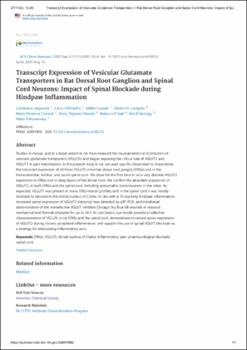| dc.description.abstract | Abstract
Studies in mouse, and to a lesser extent in rat, have revealed the neuroanatomical distribution of vesicular glutamate transporters (VGLUTs) and begun exposing the critical role of VGLUT2 and VGLUT3 in pain transmission. In the present study in rat, we used specific riboprobes to characterize the transcript expression of all three VGLUTs in lumbar dorsal root ganglia (DRGs) and in the thoracolumbar, lumbar, and sacral spinal cord. We show for the first time in rat a very discrete VGLUT3 expression in DRGs and in deep layers of the dorsal horn. We confirm the abundant expression of VGLUT2, in both DRGs and the spinal cord, including presumable motorneurons in the latter. As expected, VGLUT1 was present in many DRG neuron profiles, and in the spinal cord it was mostly localized to neurons in the dorsal nucleus of Clarke. In rats with a 10 day long hindpaw inflammation, increased spinal expression of VGLUT2 transcript was detected by qRT-PCR, and intrathecal administration of the nonselective VGLUT inhibitor Chicago Sky Blue 6B resulted in reduced mechanical and thermal allodynia for up to 24 h. In conclusion, our results provide a collective characterization of VGLUTs in rat DRGs and the spinal cord, demonstrate increased spinal expression of VGLUT2 during chronic peripheral inflammation, and support the use of spinal VGLUT blockade as a strategy for attenuating inflammatory pain.
Keywords: DRGs; VGLUTs; dorsal nucleus of Clarke; inflammatory pain; pharmacological blockade; spinal cord. | es |


